Tropical Cyclone Planetary Boundary Layer Heights Derived from GPS Radio Occultation over the Western Pacific Ocean
Abstract
:1. Introduction
2. Data Description and QC
2.1. Data Description
2.2. Data Collocation
2.3. Quality Control
3. Methodology
3.1. Traditional Definitions for PBL Height from GPS ROs
3.2. Optimization Approach Definition of Boundary Layer Height
3.3. Validation
4. Composite Structure of PBL Structure in Tropical Cyclones
5. Conclusions
Author Contributions
Funding
Data Availability Statement
Acknowledgments
Conflicts of Interest
References
- Stull, R.B. An Introduction to Boundary Layer Meteorology; Springer Science & Business Media: Berlin, MA, USA, 1988; pp. 1–27. [Google Scholar]
- Ao, C.O.; Waliser, D.E.; Chan, S.K.; Li, J.L.; Tian, B.; Xie, F.; Mannucci, A.J. Planetary boundary layer heights from GPS radio occultation refractivity and humidity profiles. J. Geophys. Res. 2012, 117, D16117. [Google Scholar] [CrossRef] [Green Version]
- Zhang, Q.; Zhang, J.; Qiao, J.; Wang, S. Relationship of atmospheric boundary layer depth with thermodynamic processes at the land surface in arid regions of China. Sci. China Earth Sci. 2011, 54, 1586–1594. [Google Scholar] [CrossRef]
- Malkus, J.S.; Riehl, H. On the Dynamics and Energy Transformations in Steady-State Hurricanes. Tellus 1960, 12, 1–20. [Google Scholar] [CrossRef] [Green Version]
- Smith, R.K.; Montgomery, M.T.; van Sang, N. Tropical cyclone spin-up revisited. Q. J. R. Meteorol. Soc. 2009, 135, 1321–1335. [Google Scholar] [CrossRef] [Green Version]
- Braun, S.A.; Tao, W. Sensitivity of High-Resolution Simulations of Hurricane Bob (1991) to Planetary Boundary Layer Parameterizations. Mon. Weather Rev. 2000, 128, 3941–3961. [Google Scholar] [CrossRef]
- Smith, R.K.; Thomsen, G.L. Dependence of tropical-cyclone intensification on the boundary-layer representation in a numerical model. Q. J. R. Meteorol. Soc. 2010, 136, 1671–1685. [Google Scholar] [CrossRef]
- Kepert, J.D. Choosing a boundary layer parameterization for tropical cyclone modeling. Mon. Weather Rev. 2012, 140, 1427–1445. [Google Scholar] [CrossRef] [Green Version]
- Zhang, J.A.; Rogers, R.F. Effects of parameterized boundary layer structure on hurricane rapid intensification in Shear. Mon. Weather Rev. 2019, 147, 853–871. [Google Scholar] [CrossRef]
- Zhang, J.A.; Rogers, R.F.; Nolan, D.S.; Marks, F.D. On the characteristic height scales of the hurricane boundary layer. Mon. Weather Rev. 2011, 139, 2523–2535. [Google Scholar] [CrossRef]
- Ming, J.; Zhang, J.A.; Rogers, R.F. Typhoon kinematic and thermodynamic boundary layer structure from dropsonde composites. J. Geophys. Res. 2015, 120, 3158–3172. [Google Scholar] [CrossRef]
- Ren, Y.; Zhang, J.A.; Vigh, J.L.; Zhu, P.; Liu, H.; Wang, X.; Wadler, J.B. An observational study of the symmetric boundary layer structure and tropical cyclone intensity. Atmosphere 2020, 11, 158. [Google Scholar] [CrossRef] [Green Version]
- Chen, N.; Tang, J.; Zhang, J.A.; Ma, L.M.; Yu, H. On the distribution of helicity in the tropical cyclone boundary layer from dropsonde composites. Atmos. Res. 2021, 249, 105298. [Google Scholar] [CrossRef]
- Beyrich, F. Mixing height estimation from sodar data—A critical discussion. Atmos. Environ. 1997, 31, 3941–3953. [Google Scholar] [CrossRef]
- Fetzer, E.J.; Teixeira, J.; Olsen, E.T.; Fishbein, E.F. Satellite remote sounding of atmospheric boundary layer temperature inversions over the subtropical eastern Pacific. Geophys. Res. Lett. 2004, 31, L17102. [Google Scholar] [CrossRef]
- Wood, R.; Bretherton, C.S. Boundary layer depth, entrainment, and decoupling in the cloud-capped subtropical and tropical marine boundary layer. J. Clim. 2004, 17, 3576–3588. [Google Scholar] [CrossRef]
- Palm, S.P.; Miller, D.; Benedetti, A.; Spinhirne, J. Validation of ECMWF global forecast model parameters using the geoscience laser altimeter system (GLAS) atmospheric channel measurements. Geophys. Res. Lett. 2005, 32, L22S09. [Google Scholar] [CrossRef]
- Jordan, N.S.; Hoff, R.M.; Bacmeister, J.T. Validation of Goddard Earth Observing System-version 5 MERRA planetary boundary layer heights using CALIPSO. J. Geophys. Res. 2010, 115, 9–12. [Google Scholar] [CrossRef] [Green Version]
- Kursinski, E.R.; Hajj, G.A.; Schofield, J.T.; Linfield, R.P.; Hardy, K.R. Observing Earth’s atmosphere with radio occultation measurements using the global positioning system. J. Geophys. Res. Atmos. 1997, 102, 23429–23465. [Google Scholar] [CrossRef]
- Chen, S.Y.; Liu, C.Y.; Huang, C.Y.; Hsu, S.C.; Li, H.W.; Lin, P.H.; Cheng, J.P.; Huang, C.Y. An Analysis Study of FORMOSAT-7/COSMIC-2 Radio Occultation Data in the Troposphere. Remote Sens. 2021, 13, 717. [Google Scholar] [CrossRef]
- Ho, S.P.; Zhou, X.; Shao, X.; Zhang, B.; Adhikari, L.; Kireev, S.; He, Y.; Yoe, J.G.; Xia-Serafino, W.; Lynch, E. Initial assessment of the COSMIC-2/FORMOSAT-7 neutral atmosphere data quality in NESDIS/STAR using in situ and satellite data. Remote Sens. 2020, 12, 4099. [Google Scholar] [CrossRef]
- Basha, G.; Ratnam, M.V. Identification of atmospheric boundary layer height over a tropical station using high-resolution radiosonde refractivity profiles: Comparison with GPS radio occupation measurements. J. Geophys. Res. 2009, 114, D16101. [Google Scholar] [CrossRef]
- Guo, P.; Kuo, Y.-H.; Sokolovskiy, S.V.; Lenschow, D.H. Estimating Atmospheric Boundary Layer Depth Using COSMIC Radio Occultation Data. J. Atmos. Sci. 2011, 68, 1703–1713. [Google Scholar] [CrossRef]
- Xie, F.; Wu, D.L.; Ao, C.O.; Mannucci, A.J.; Kursinski, E.R. Advances and limitations of atmospheric boundary layer observations with GPS occultation over southeast Pacific Ocean. Atmos. Chem. Phys. 2012, 12, 903–918. [Google Scholar] [CrossRef] [Green Version]
- Ho, S.; Peng, L.; Anthes, R.A.; Kuo, Y.; Lin, H. Marine Boundary Layer Heights and Their Longitudinal, Diurnal, and Interseasonal Variability in the Southeastern Pacific Using COSMIC, CALIOP, and Radiosonde Data. J. Clim. 2015, 28, 2856–2872. [Google Scholar] [CrossRef] [Green Version]
- Xu, X.; Zou, X. COSMIC-2 RO Profile Ending at PBL Top with Strong Vertical Gradient of Refractivity. Remote Sens. 2022, 14, 2189. [Google Scholar] [CrossRef]
- Kuo, Y.H.; Wee, T.K.; Sokolovskiy, S.; Rocken, C.; Schreiner, W.; Hunt, D.; Anthes, R.A. Inversion and error estimation of GPS radio occultation data. J. Meteorol. Soc. Jpn. 2004, 82, 507–531. [Google Scholar] [CrossRef] [Green Version]
- Anthes, R.A.; Bernhardt, P.A.; Chen, Y.; Cucurull, L.; Dymond, K.F.; Ector, D.; Healy, S.B.; Ho, S.-P.; Hunt, D.C.; Kuo, Y.-H.; et al. The COSMIC/FORMOSAT-3 Mission: Early Results. Bull. Am. Meteorol. Soc. 2008, 89, 313–334. [Google Scholar] [CrossRef]
- Ao, C.O.; Hajj, G.A.; Meehan, T.K.; Dong, D.; Iijima, B.A.; Mannucci, A.J.; Kursinski, E.R. Rising and setting GPS occupations by use of open-loop tracking. J. Geophys. Res. Atmos. 2009, 114, D04101. [Google Scholar] [CrossRef] [Green Version]
- Yang, S.; Zou, X.; Ray, P.S. Comparison of TC temperature and water vapor climatologies between the Atlantic and Pacific Oceans from GPS RO observations. J. Clim. 2018, 31, 8557–8571. [Google Scholar] [CrossRef]
- Yang, S.; Zou, X. Relationships of along-the-track local variations of GPS RO impact parameter to strong local vertical gradient of wet refractivity in the tropics. Sci. China Earth Sci. 2021, 64, 2015–2026. [Google Scholar] [CrossRef]
- Yang, S.; Zou, X.; Anthes, R. Raytracing simulated GPS radio wave propagation paths experiencing large disturbances when going through the top of the sub-cloud layer. Remote Sens. 2021, 13, 4693. [Google Scholar] [CrossRef]
- Sokolovskiy, S.; Rocken, C.; Schreiner, W.; Hunt, D. On the uncertainty of radio occultation inversions in the lower troposphere. J. Geophys. Res. Atmos. 2010, 115, D22111. [Google Scholar] [CrossRef] [Green Version]
- Liu, H.; Kuo, Y.H.; Sokolovskiy, S.; Zou, X.; Zeng, Z.; Hsiao, L.F.; Ruston, B.C. A quality control procedure based on bending angle measurement uncertainty for radio occultation data assimilation in the tropical lower troposphere. J. Atmos. Ocean. Technol. 2018, 35, 2117–2131. [Google Scholar] [CrossRef]
- Lanzante, J.R. Resistant, robust and non-parametric techniques for the analysis of climate data: Theory and examples, including applications to historical radiosonde station data. Int. J. Climatol. 1996, 16, 1197–1226. [Google Scholar] [CrossRef]
- Zou, X.; Zeng, Z. A quality control procedure for GPS radio occultation data. J. Geophys. Res. Atmos. 2006, 111, 111. [Google Scholar] [CrossRef] [Green Version]
- Seidel, D.J.; Ao, C.O.; Li, K. Estimating climatological planetary boundary layer heights from radiosonde observations: Comparison of methods and uncertainty analysis. J. Geophys. Res. Atmos. 2010, 115, 6113. [Google Scholar] [CrossRef] [Green Version]
- Liu, S.; Liang, X.Z. Observed diurnal cycle climatology of planetary boundary layer height. J. Clim. 2010, 23, 5790–5809. [Google Scholar] [CrossRef]
- Von Engeln, A.; Teixeira, J. A planetary boundary layer height climatology derived from ECMWF reanalysis data. J. Clim. 2013, 26, 6575–6590. [Google Scholar] [CrossRef]
- Smith, E.K.; Weintraub, S. The Constants in the Equation for Atmospheric Refractive Index at Radio Frequencies. Proc. IRE 1953, 41, 1035–1037. [Google Scholar] [CrossRef] [Green Version]
- Ahern, K.; Bourassa, M.A.; Hart, R.E.; Zhang, J.A.; Rogers, R.F. Observed Kinematic and Thermodynamic Structure in the Hurricane Boundary Layer during Intensity Change. Mon. Weather Rev. 2019, 147, 2765–2785. [Google Scholar] [CrossRef]
- Zhang, J.A.; Dunion, J.P.; Nolan, D.S. In Situ Observations of the Diurnal Variation in the Boundary Layer of Mature Hurricanes. Geophys. Res. Lett. 2020, 47, GL086206. [Google Scholar] [CrossRef]
- Molinari, J.; Frank, J.; Vollaro, D. Convective bursts, downdraft cooling and boundary layer recovery in a sheared tropical storm. Mon. Weather Rev. 2013, 141, 1048–1060. [Google Scholar] [CrossRef]
- Ming, J.; Zhang, J.A.; Rogers, R.F.; Marks, F.D.; Wang, Y.; Cai, N. Multiplatform observations of boundary layer structure in the outer rainbands of landfalling typhoons. J. Geophys. Res. 2014, 119, 7799–7814. [Google Scholar] [CrossRef]
- Zhang, J.A.; Drennan, W.M.; Black, P.G.; French, J.R. Turbulence structure of the hurricane boundary layer between the outer rainbands. J. Atmos. Sci. 2009, 66, 2455–2467. [Google Scholar] [CrossRef]
- Kepert, J.D. Slab- and height-resolving models of the tropical cyclone boundary layer. Part I: Comparing the simulations. Q. J. R. Meteorol. Soc. 2010, 136, 1686–1699. [Google Scholar] [CrossRef]
- Knaff, J.A.; Longmore, S.P.; Molenar, D.A. An objective satellite-based tropical cyclone size climatology. J. Clim. 2014, 27, 455–476. [Google Scholar] [CrossRef]
- Chavas, D.R.; Emanuel, K.A. A QuikSCAT climatology of tropical cyclone size. Geophys. Res. Lett. 2010, 37, L18816. [Google Scholar] [CrossRef] [Green Version]
- Schenkel, B.A.; Lin, N.; Chavas, D.; Oppenheimer, M.; Brammer, A. Evaluating outer tropical cyclone size in reanalysis datasets using QuikSCAT data. J. Clim. 2017, 30, 8745–8762. [Google Scholar] [CrossRef]
- Yang, S.; Zou, X. Assessments of cloud liquid water contributions to GPS radio occultation refractivity using measurements from COSMIC and CloudSat. J. Geophys. Res. Atmos. 2012, 117, D06219. [Google Scholar] [CrossRef] [Green Version]
- Shi, D.; Chen, G.; Wang, K.; Bi, X.; Chen, K. Evaluation of Two Initialization Schemes for Simulating the Rapid Intensification of Typhoon Lekima (2019). Adv. Atmos. Sci. 2020, 37, 987–1006. [Google Scholar] [CrossRef]
- Bell, M.M.; Montgomery, M.T.; Emanuel, K.A. Air–Sea Enthalpy and Momentum Exchange at Major Hurricane Wind Speeds Observed during CBLAST. J. Atmos. Sci. 2012, 69, 3197–3222. [Google Scholar] [CrossRef]
- Zhang, J.A.; Rogers, R.F.; Tallapragada, V. Impact of parameterized boundary layer structure on tropical cyclone rapid intensification forecasts in HWRF. Mon. Weather Rev. 2017, 145, 1413–1426. [Google Scholar] [CrossRef]
- Johnston, B.; Xie, F. Characterizing Extratropical Tropopause Bimodality and its Relationship to the Occurrence of Double Tropopauses Using COSMIC GPS Radio Occultation Observations. Remote Sens. 2020, 12, 1109. [Google Scholar] [CrossRef] [Green Version]
- Schmidt, T.; Beyerle, G.; Heise, S.; Wickert, J.; Rothacher, M. A climatology a multiple tropauses derived from GPS radio occultations with CHAMP and SAC-C. Geophys. Res. Lett. 2006, 33, L04807. [Google Scholar] [CrossRef]
- Noersomadi; Tsuda, T.; Fujiwara, M. Influence of ENSO and MJO on the zonal structure of tropical tropopause inversion layer using high-resolution temperature profiles retrieved from COSMIC GPS Radio Occultation. Atmos. Chem. Phys. 2019, 19, 6985–7000. [Google Scholar] [CrossRef] [Green Version]
- Ahern, K.; Hart, R.E.; Bourassa, M.A. Asymmetric Hurricane Boundary Layer Structure during Storm Decay. Part I: Formation of Descending Inflow. Mon. Weather Rev. 2021, 149, 3851–3874. [Google Scholar] [CrossRef]
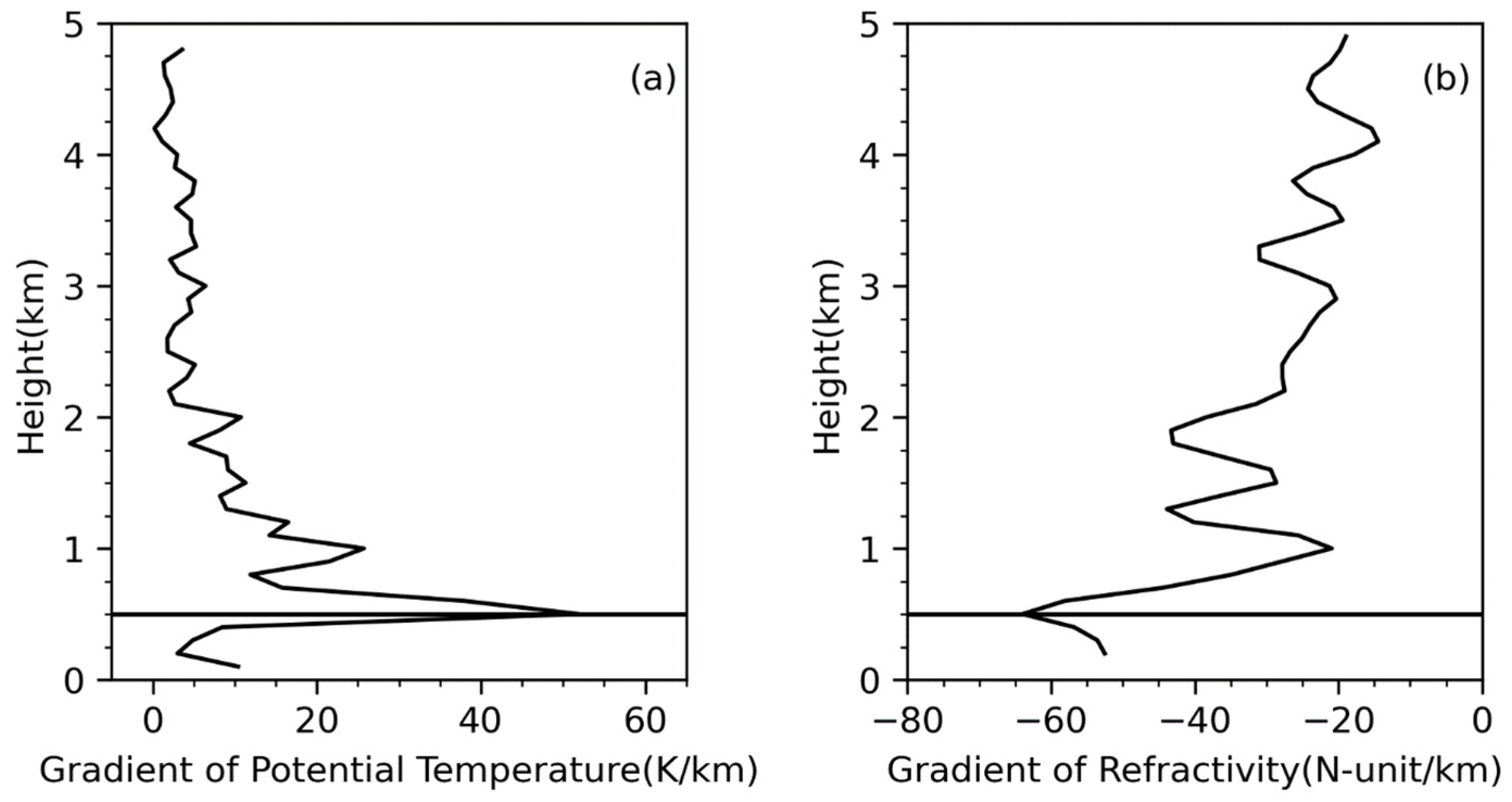




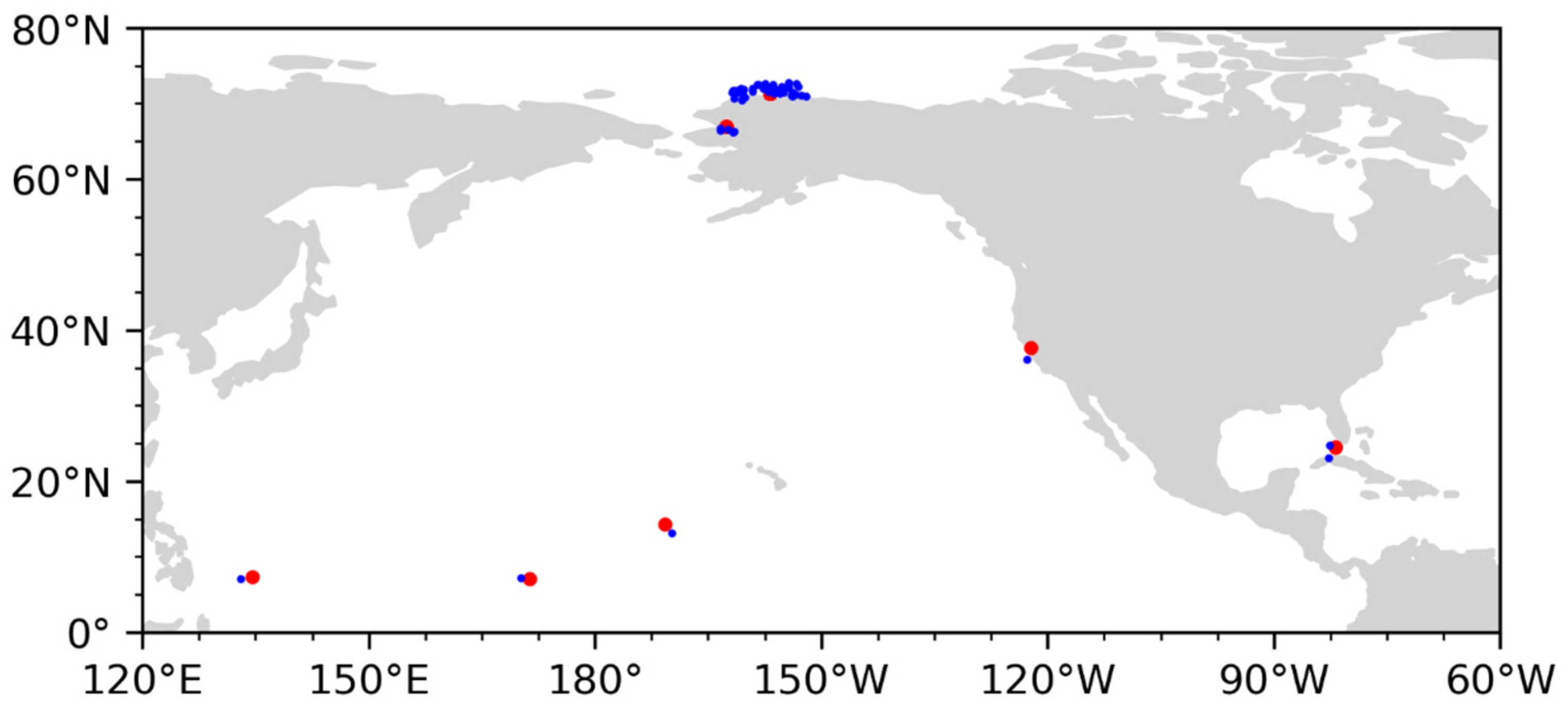

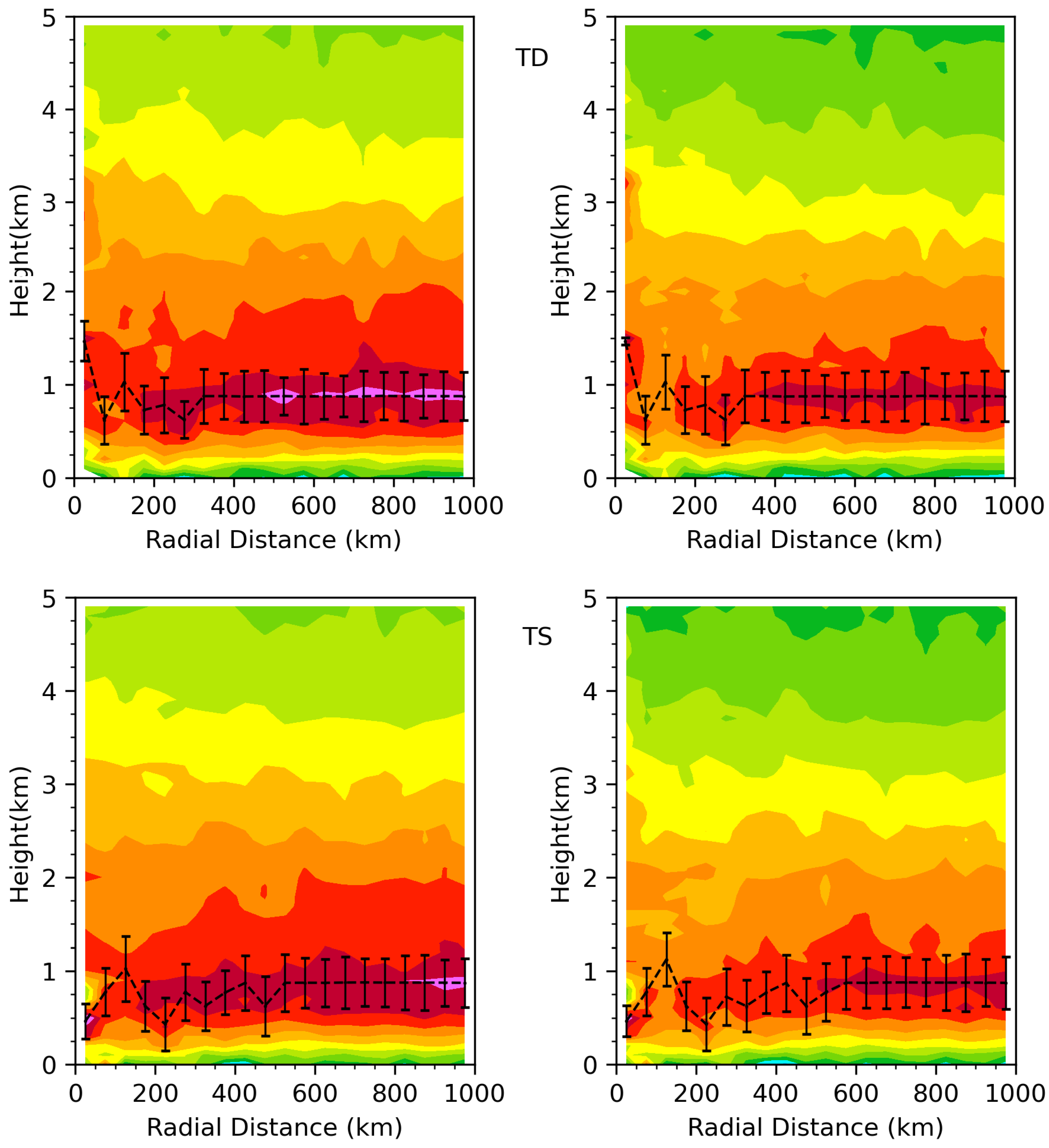
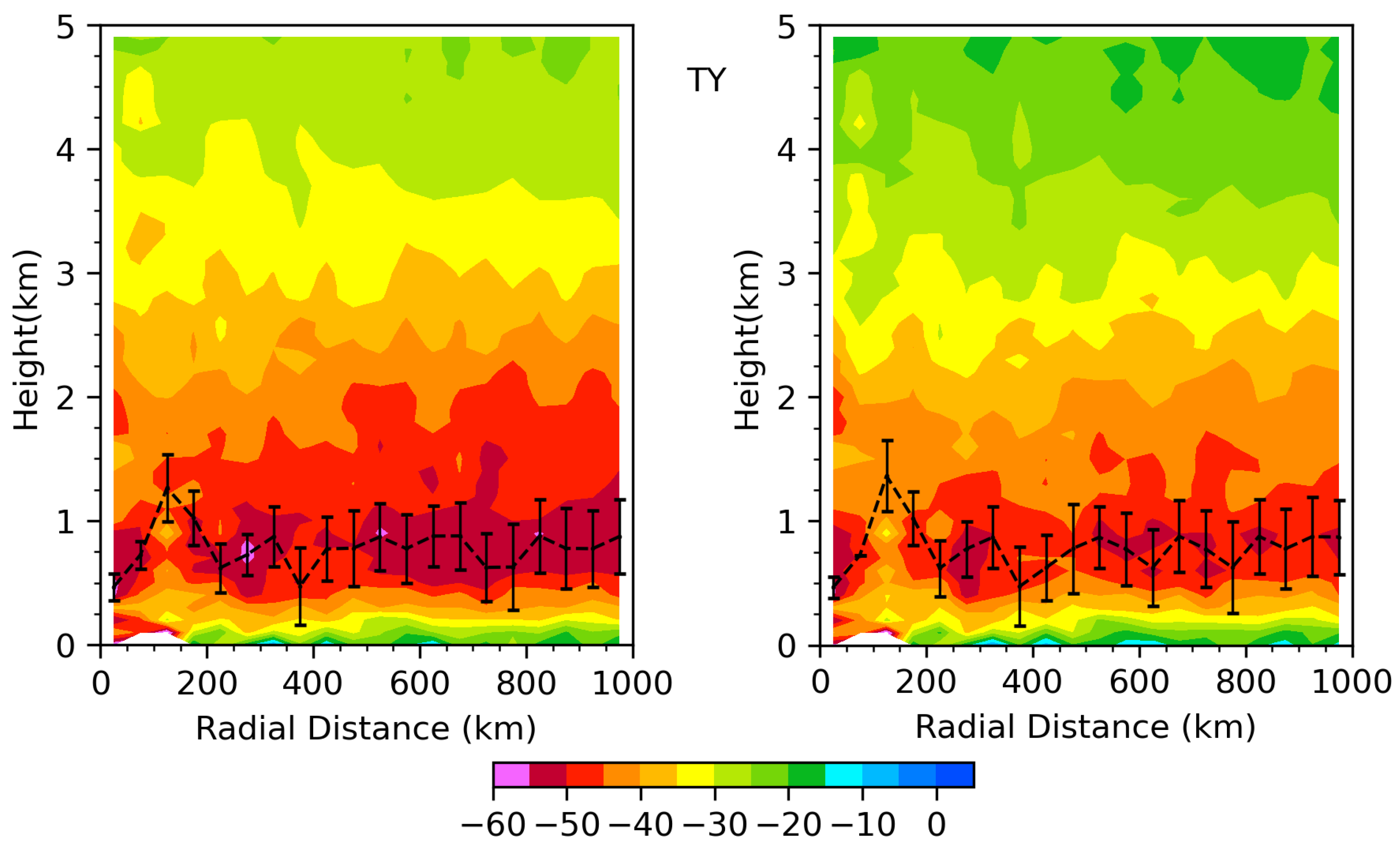
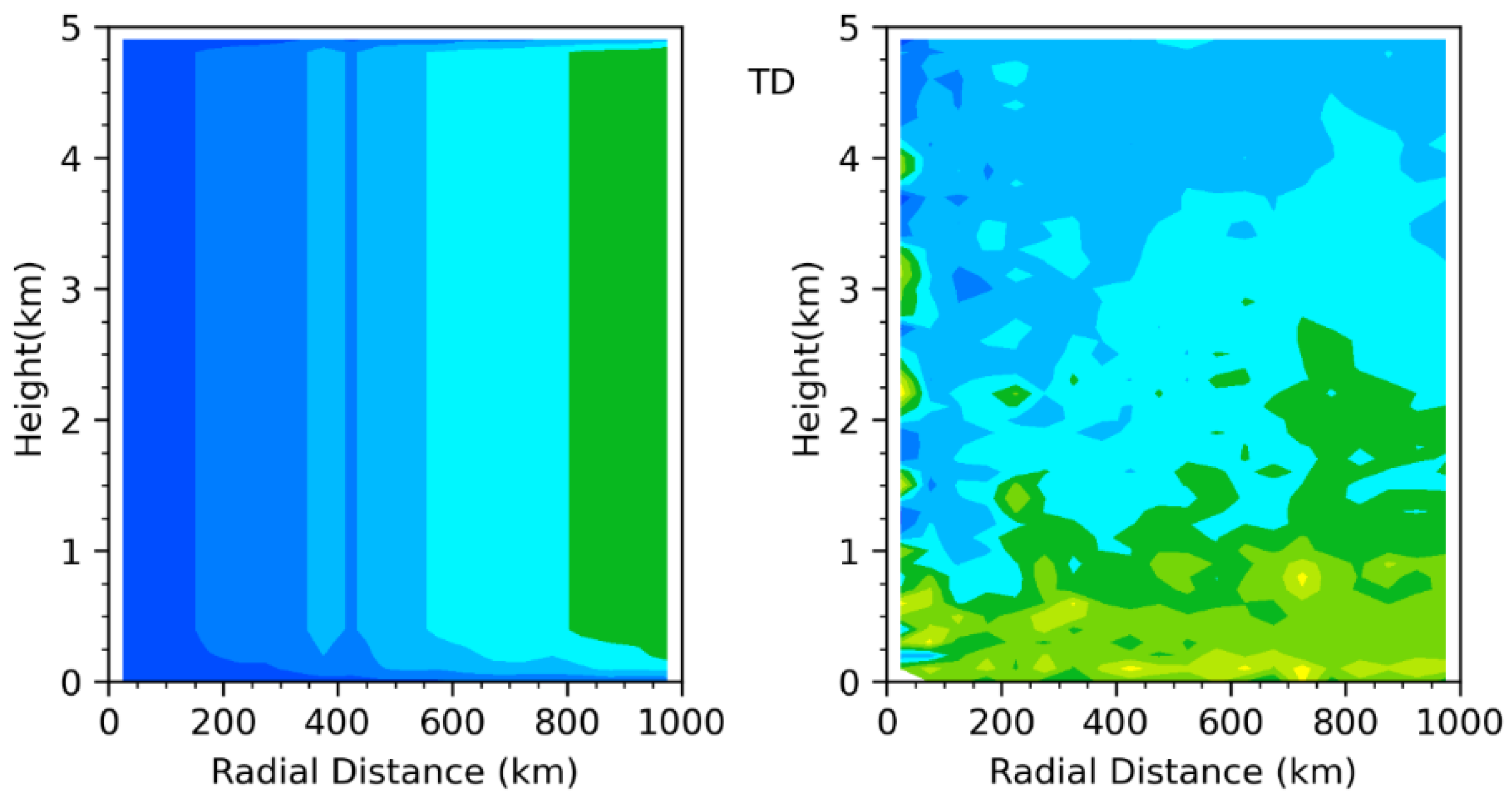
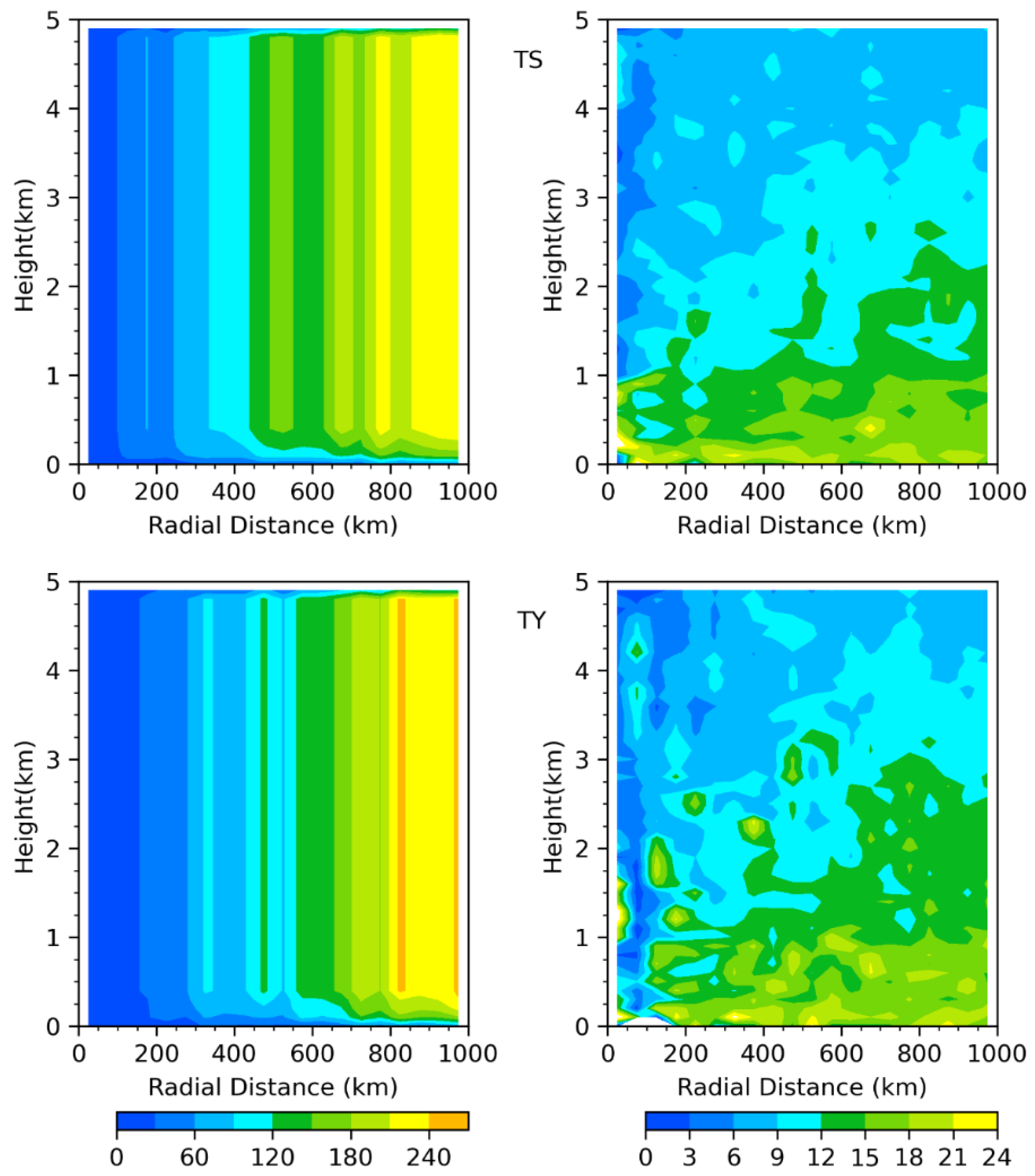

Publisher’s Note: MDPI stays neutral with regard to jurisdictional claims in published maps and institutional affiliations. |
© 2022 by the authors. Licensee MDPI, Basel, Switzerland. This article is an open access article distributed under the terms and conditions of the Creative Commons Attribution (CC BY) license (https://creativecommons.org/licenses/by/4.0/).
Share and Cite
Wang, L.; Yang, S.; Lin, L. Tropical Cyclone Planetary Boundary Layer Heights Derived from GPS Radio Occultation over the Western Pacific Ocean. Remote Sens. 2022, 14, 6110. https://doi.org/10.3390/rs14236110
Wang L, Yang S, Lin L. Tropical Cyclone Planetary Boundary Layer Heights Derived from GPS Radio Occultation over the Western Pacific Ocean. Remote Sensing. 2022; 14(23):6110. https://doi.org/10.3390/rs14236110
Chicago/Turabian StyleWang, Li, Shengpeng Yang, and Lin Lin. 2022. "Tropical Cyclone Planetary Boundary Layer Heights Derived from GPS Radio Occultation over the Western Pacific Ocean" Remote Sensing 14, no. 23: 6110. https://doi.org/10.3390/rs14236110
APA StyleWang, L., Yang, S., & Lin, L. (2022). Tropical Cyclone Planetary Boundary Layer Heights Derived from GPS Radio Occultation over the Western Pacific Ocean. Remote Sensing, 14(23), 6110. https://doi.org/10.3390/rs14236110





